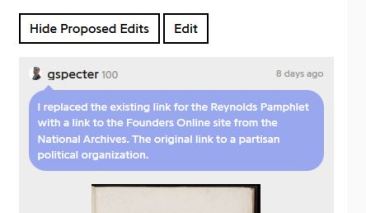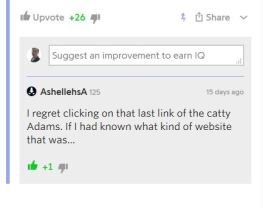If you follow me on Twitter or have read my post over at Pedagogy and American Literary Studies, then you likely know I’ll be incorporating Hamilton: An American Musical in one of my classes this coming semester.
In other words, “if ya don’t know, now ya know.”
In my class I’ll be approaching Hamilton by pairing it with several excellent of examples of public writing written by historians and cultural critics. Additionally, I plan on pairing Hamilton with several online exhibitions from various museums and libraries.
However, I’m on the fence about using the annotations for Hamilton provided by the website, Genius.

Genius is a crowd-sourced and web-based platform that allows users to annotate the lyrics of songs. Genius originally began as a way to annotate the lyrics of rap music, but has since expanded to a variety of other texts, including Hamilton. On the surface, Genius is cool. It allows for crowdsourced knowledge that can be enhanced with links, images, and gifs. It allows for annotations and comments from users. Many works, like Hamilton, can be linked with YouTube or platforms like Spotify that allow for a multimedia experience that echoes the format of VH1’s Pop-Up Video. On first pass, it is a dizzying array of resources presented in a fresh and exiting way. As other people have noted the applications for the classroom are apparent.

However, Genius has an authority problem that centers on a veneration of Lin-Manuel Miranda and the musical’s major source material, Ron Chernow’s biography of Hamilton. The community of editors on Genius makes the veneration of both Chernow and Miranda clear in the instructions and advice to new annotators of Hamilton. One of the editors’ stated goals involves Miranda verifying annotations. Another piece of advice extols users to #CheckInWithChernow. Andrew M. Schocket addresses the problems with the history detailed by Chernow, especially in light of the biography’s resurgence in the wake of the musical’s success. And Schocket isn’t alone. William Hogeland, on Twitter and his blog, has critqued the problem of the musical and its main source material. As a teaching tool, the issues with Genius and Hamilton result in a thorny intertext that requires spending extensive time working through issues of the practice of history as a field, dealing with source evaluation, or exposing students to issues of authority.
First year students often have difficulty navigating issues of authority when it comes to evaluating sources. The difficulty of students becoming critical readers and thinkers, especially in their first semester, is one reason that I find myself pondering the authority problem of Hamilton and the Genius annotations. Chernow’s biography has many of the hallmarks that students see as a “good source”: it is big, it has notes, and it has a bibliography. Or, as the Grumpy Historian, pointed out on Twitter, Chernow’s biography is an example of “How biography (and primary sources, and footnotes) can hide #BadHistory.”
I am wavering on my class using the Genius annotations for Hamilton. It is an extensive source that could be used in powerful ways to discuss authority and source evaluation. I’m using Hamilton in the context of a composition class. We will address issues of authority and the evaluation of sources. However, we can’t do everything in as much depth as I would like. My main focus has to be on wiring instruction. There is not enough time in the classroom. I imagine that there would be more time to devote to such issues in an upper-level class.

Perhaps the solution is to fix the Genius annotations of Hamilton. Extensive revisions could be done in a class focused on public writing or digital writing. I did an experiment. I wanted to see how easily Genius annotations could be revised and updated. I set up an account on Genius. I created a profile in which I leveraged my academic authority. I made a revision to “The Reynolds Pamphlet.” I made a small suggestion. The original annotation links to a full-text version of “The Reynolds Pamphlet” provided by a partisan political website. I altered the link to take users to a full-text version of “The Reynolds Pamphlet” provided on the Founders Online site from the National Archives. I left a comment that I made the change and the reason for the change. Perhaps there is an even better link I could use, but the purpose of my edit was to incorporate a sound source and see if the change would be accepted.
As a result of this experience I learned that revising annotations on Genius is not as easy as revising entries on Wikipedia. I made my edit on June 30th and it is now July 8th. The original annotation for “The Reynolds Pamphlet” has not been updated. If users click on the list of proposed edits, located at the bottom, then they can see my proposed change. In the intervening days between my edit and writing this post, I did receive an upvote on my proposed change. Small victories.
As another experiment, prior to writing this post, I took a look at the annotations for the line “Martha Washington named her feral tomcat after him” from the song “A Winter’s Ball.” I did this in the wake of a recent article that exploring the veracity of this anecdote. As Joanne Freeman noted on Twitter: “Seems like a non-story, folks, as I noted when interviewed yesterday. Story clearly from a 19th c “story” book.” I thought the “tomcat” line could be a quick candidate for an easy revision. Believe it or not, there are extensive annotations to this one line of the song. It was not a candidate for a quick edit and I didn’t make any changes.

I noticed, in reading the annotations of the “tomcat” line, that one of the annotations takes Genius users to a partisan blog on Hamilton and Christianity. An additional link takes users to another partisan political website with an article on Hamilton and John and Abigail Adams. Genius annotations for Hamilton reveal links to similarly partisan websites and blogs. However, making meaningful edits to Genius is not as easy as it appears, as my experience with “The Reynolds Pamphlet” shows. Making revisions isn’t just about changing links. Much of the information from the sites cited by users is extensively embedded in the user-generated content on Genius.
Revisions of Hamilton on Genius are needed if the site has potential uses for the classroom, which makes such a project a seemingly ideal candidate for an upper-division class with a digital humanities or public writing focus. Last summer, I wrote about the potential of a digital humanities project focusing on revising entries of American women writers on Find A Grave. In my post I addressed the potential difficulties of such a project because of the prevalence of entries locked by users, many of whom are no longer active users. Hamilton on Genius has many of the same problems because the entries are a year old and the editors behind the project may no longer be active.
I thought writing this post would help me make a firm decision about using Genius in my classroom. I’m still not sure. One reason I like Genius is because it is a repository of musical and cultural references that I’m not in a position to connect for students. However, if my extra credit assignment on Hamilton is any indication, students are very capable of making the popular cultural connections that I can’t provide for them.
I still have a few weeks to plan my classes. I’ll no doubt continue to waiver on the topic of using Genius in the classroom. In the meantime, I’d love to hear your thoughts!